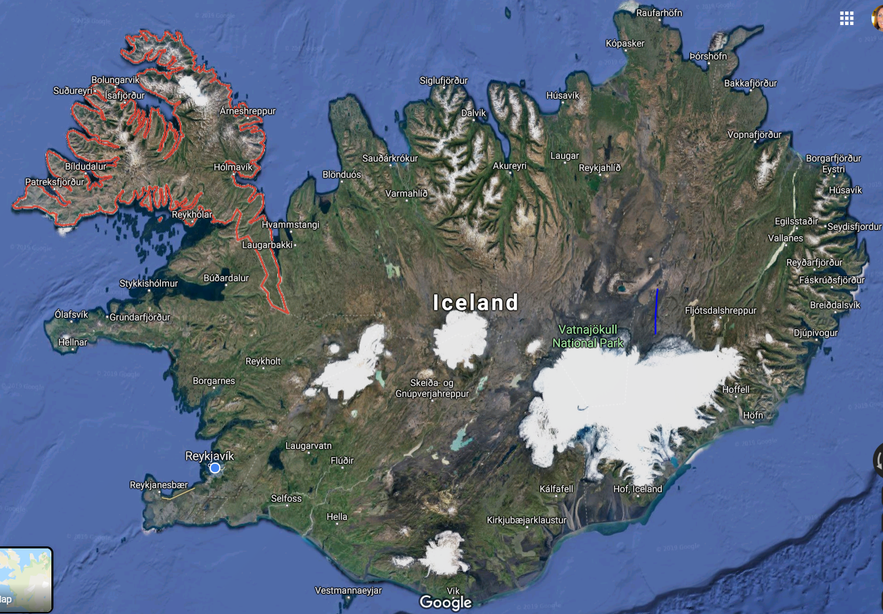
The 3 Trolls who wanted to separate the Westfjords Region from the Mainland of Iceland - Icelandic Folklore - Vestfjarðatröllin
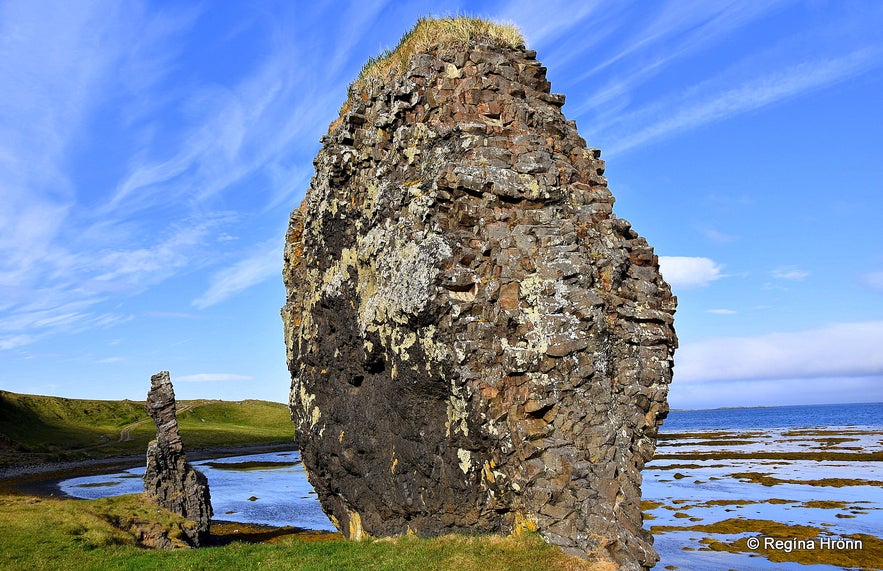
Icelandic folklore contains a lot of elf- and troll stories and I have shown you many such locations in my travel-blog. A well-known Icelandic troll story tells us about the 3 trolls who wanted to sever the Westfjords Region from the mainland of Iceland and keep the Westfjords Region as a troll country.
While staying at Kirkjuból at Strandir for 3 days I visited 2 of the trolls. I had already visited the 3rd troll on several occasions, but that troll is to be found across Steingrímsfjörður bay and gives the name to Drangsnes.
Top photo: Vestfjarðatröllin - the Westfjord Trolls

The 2 trolls in the distance in Kollafjörður
I had been looking for the 2 remaining trolls for some time and had driven past them several times without knowing their exact location.
The farmers at Kirkjuból, who run the Kirkjuból guesthouse and Sauðfjársetrið - the Sheep Farming Museum - told me where to find them. The gravel road leading to the trolls is not marked so you will have to know the exact location. They are located at 65.603922, -21.411752.
The Sheep Farming Museum and Kirkjuból are located off road 60 some 6 km further along road 68. To reach the 2 trolls drive further along road 68 into Kollafjörður. They are to be found approximately 12 km from the guesthouse Kirkjuból.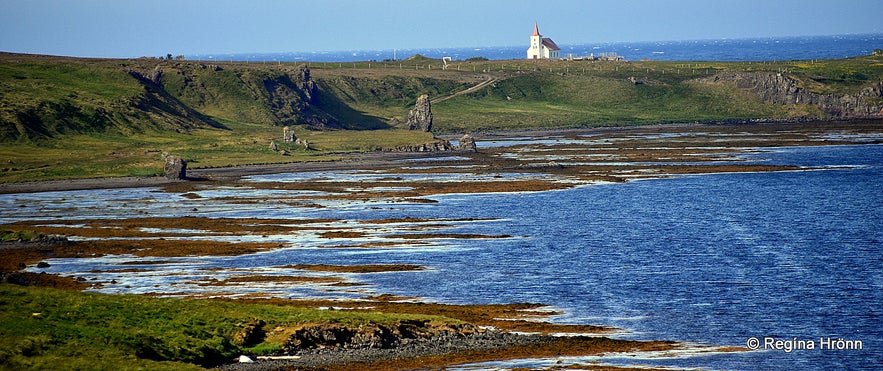
Kollafjarðarneskirkja church in the distance and the 2 trolls
You will see Kollafjarðarneskirkja church down by the sea from the main road. After you see the church from the road, drive for about half a kilometre on road 68, until you reach an unmarked gravel road on your left.
Drive down this road in the direction of the sea until you see the cairn in my second photo. In the distance, you will see the 2 trolls. It is best to leave your car there and walk down to the trolls. There is a very bumpy and rocky trail leading to the trolls so it is best to walk.
The first time we visited the trolls was during a rainstorm. The day after the sun shone brightly, so we visited the trolls again to get better photos.
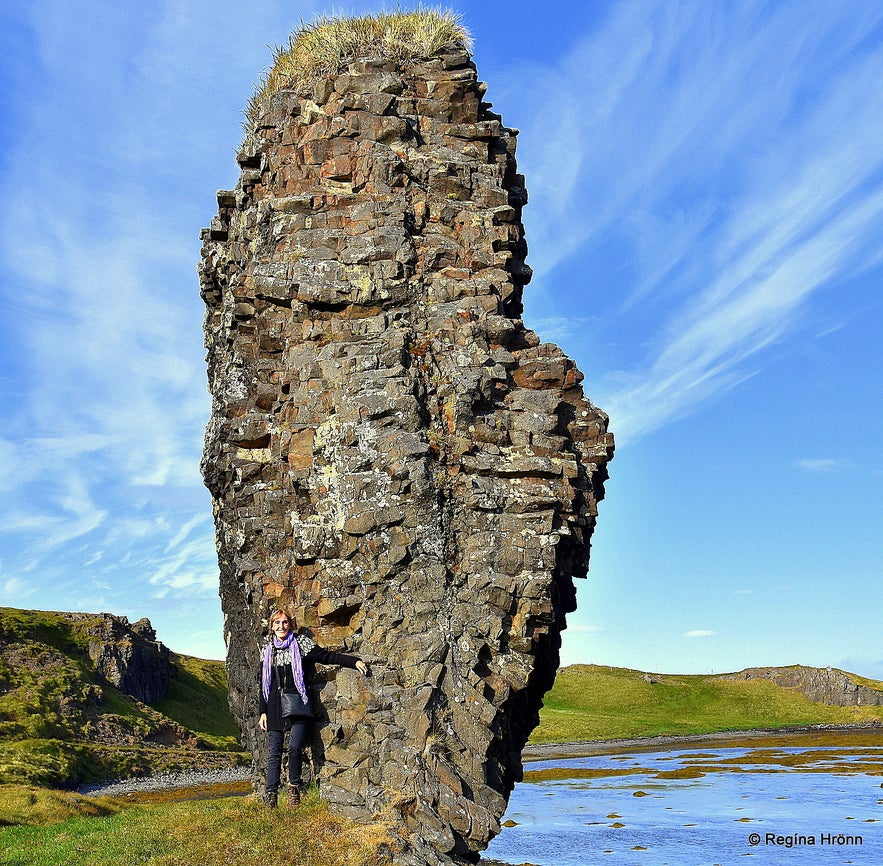
One of the Westfjord trolls
I found the folklore in Þjóðsögur Jóns Árnasonar - the Collection of Folklore by Jón Árnason. It is called Tröllin á Vestfjörðum or the Trolls in the Westfjords and goes like this:
"In ancient times (after the settlement of Iceland) there were three trolls in the Westfjords who wanted to dig a channel between the Westfjords and the other country (the mainland of Iceland), between Gilsfjörður and Kollafjörður fjords, close to where it is at its narrowest."
Here you can see how the Westfjords Region looks like the head of Iceland
We locals often refer to the Westfjords as the head of Iceland and you will see why if you look at the map.
So the trolls wanted to dig through the neck and sever the head from the rest of Iceland.
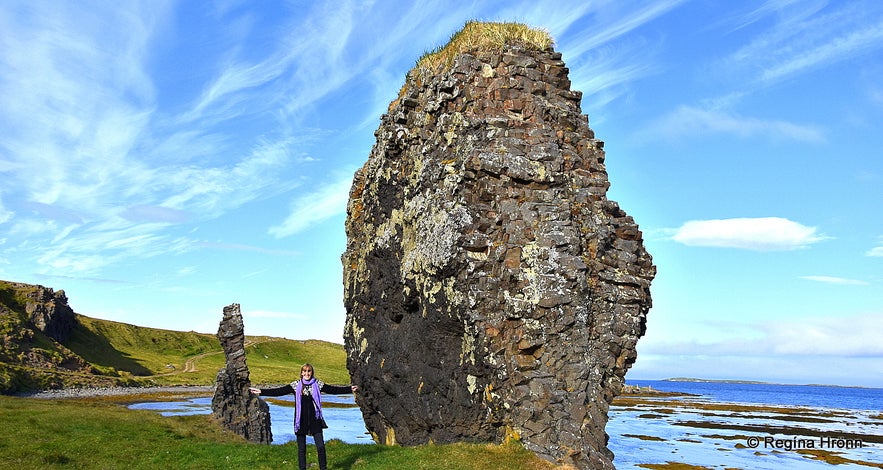
Holding hands with two of the Westfjord trolls
"At the same time, the trolls had another purpose; they wanted to build islands from the material they dug from the channel.
The trolls digging on the west side had a speedier process, as Breiðafjörður bay was shallower than Húnaflói and two trolls were digging there, Karl and Kerling, and they formed all the islands dotted on Breiðafjörður, looking like skyr with berries."
These islands are innumerable and counted among the 3 innumerable things in Icelandic nature. I have written another travel-blog about a boat tour on Breiðafjörður, where you can see some of the many islands:
A lovely Boat Tour with Seatours on Breiðafjörður in West Iceland - the Viking Sushi Adventure
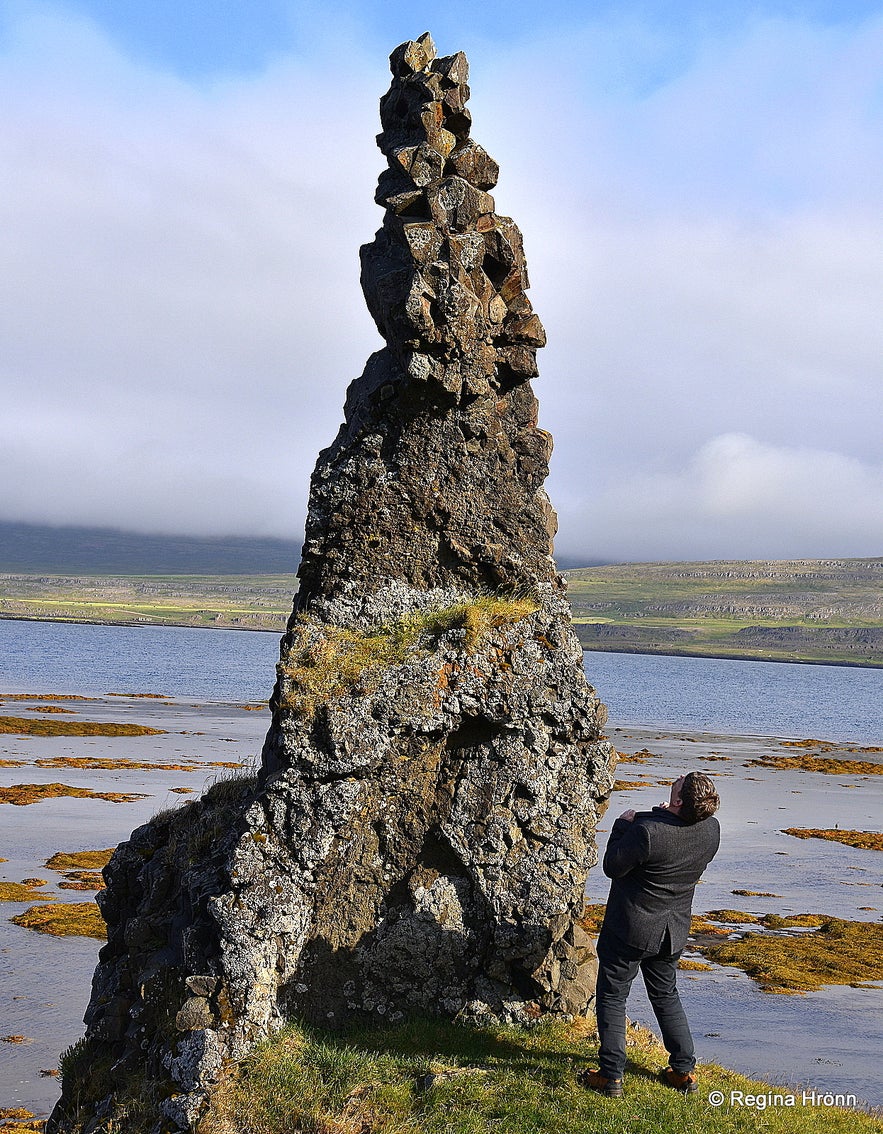
One of the Westfjord trolls and my husband
"But the troll woman Kerling on the east side wasn't making much progress by herself, as Húnaflói bay is both deeper and the islands she was supposed to create turned into sunken skerries; everything went awry.
The trolls were digging through the night and didn't pay attention to how quickly time passed and that the sun was rising.
When they noticed, the trolls on the west side started running and ran as fast as they could east and north across Steinadalsheiði heath and meant to hide in Kollafjörður bay.
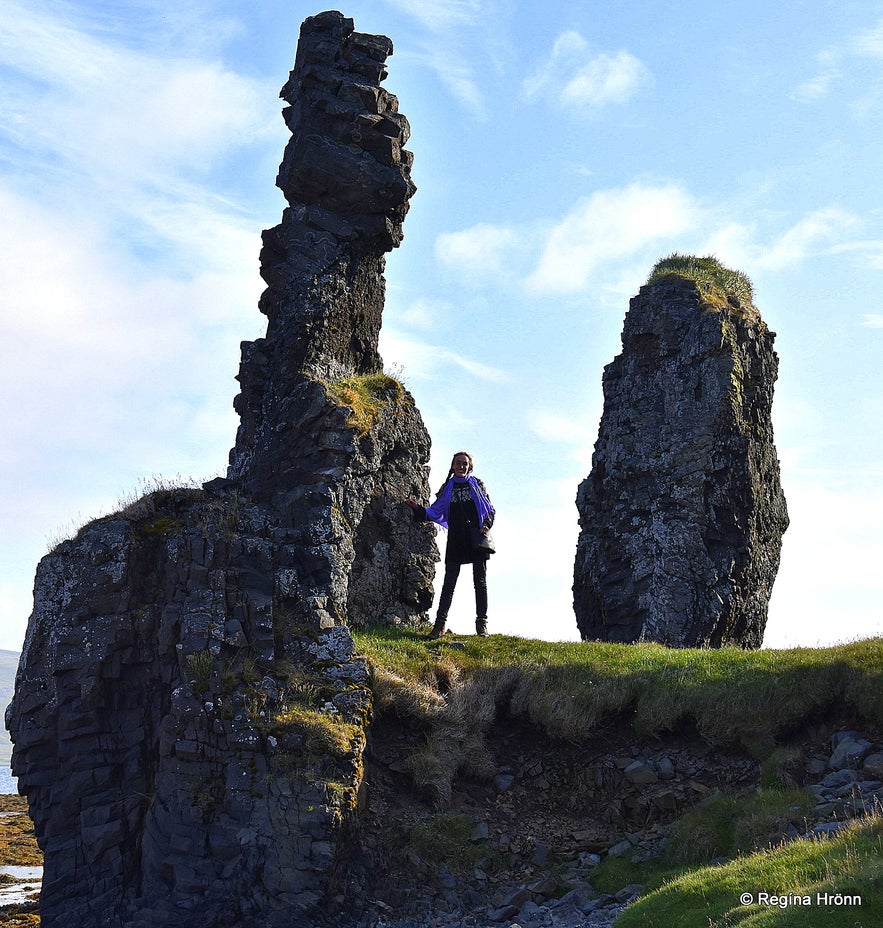
With two of the Westfjord trolls
But as they reached the seafront the sun rose and they got turned into rocks, which are called Drangar. (As we all know then night-trolls get turned into stone by the sun). They stand together at Drangavík close to Kollafjarðarnes cape.
The bigger rock, which is narrower at the bottom is Karl, the Troll, and the other rock is peaked, and fatter at the bottom, so it looks like it has a stomach and even thighs; that is Kerling or the female troll.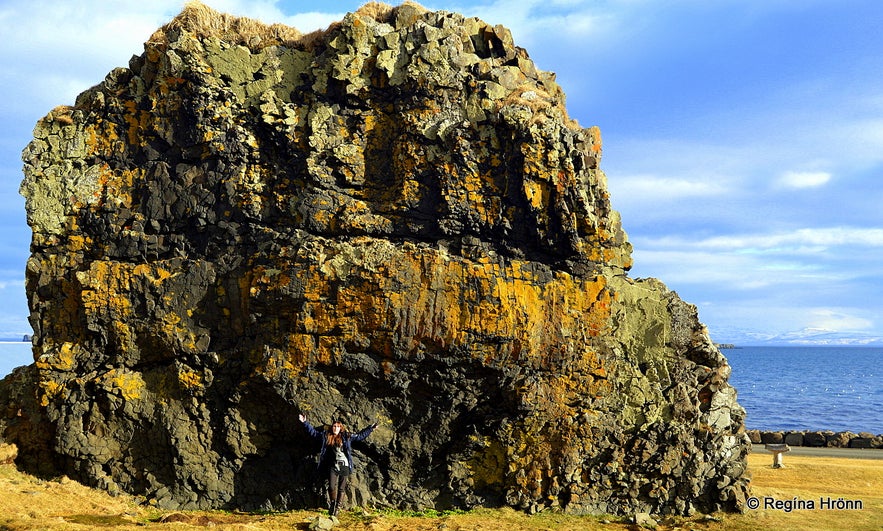
The female troll Kerling in Drangsnes on the other side of the fjord
The Kerling who was digging on the east side also got caught by the rays of the sun.
As she noticed the sunrise she jumped north across Steinsgrímsfjörður fjord and stopped by an escarpment north of the fjord, by the name of Malarhorn, where the sun shone upon her.
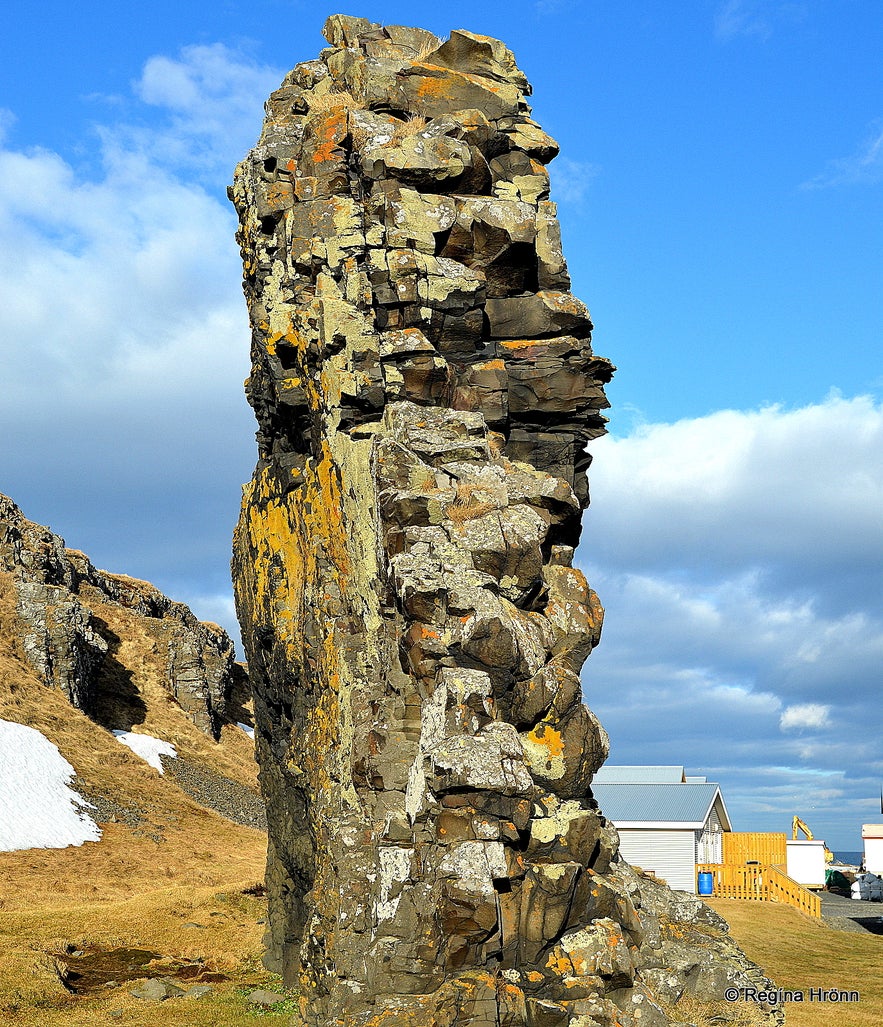
The female troll Kerling in Drangsnes
Kerling was livid as she had not been able to create but a few islets and skerries on the Húnaflói bay, that she slammed her shovel down in anger, and the big blow broke off a piece of land which formed Grímsey island, which still stands in Steingrímsfjörður fjord.
It is the only big island that Kerling was able to create. The story goes that the rocks on the island are of the same material as at Malarhorn, so they seem to be created from the same rock.
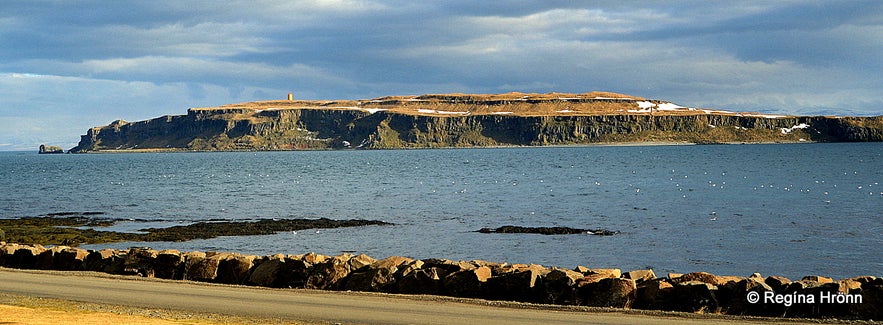
Grímsey island and the bull on the left side of the island
On the east side of Grímsey island, you will find a rock in the shape of a bull; it stands tall and erect. This rock is called Uxi or the Bull. Its pointy end looks like a church tower; that is the bull's horns.
The bull belonged to Kerling, but she had left her bull on the part which separated from Malarhorn; the bull then turned into stone as his owner."
Kerling was turned into stone as well while looking back at her bull on the island. 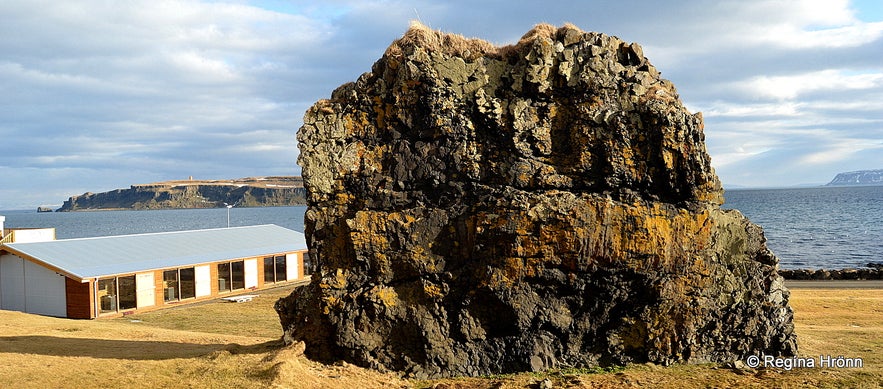
Drangur Kerling looking in the direction of her bull by Grímsey island. It is located at Malarhorn close to the swimming pool in Drangsnes
"Since then nobody has tried to separate the Westfjords from the mainland nor tried to create islands and skerries on the Húnaflói bay and Breiðafjörður fjord".
(Translated into English and recapitulated from Þjóðsögur Jóns Árnasonar - the Collection of Folklore by Jón Árnason)
This was the story about the 3 trolls, who meant to separate the Westfjords Region from the mainland of Iceland. I love such stories and search for their locations on my travels around Iceland.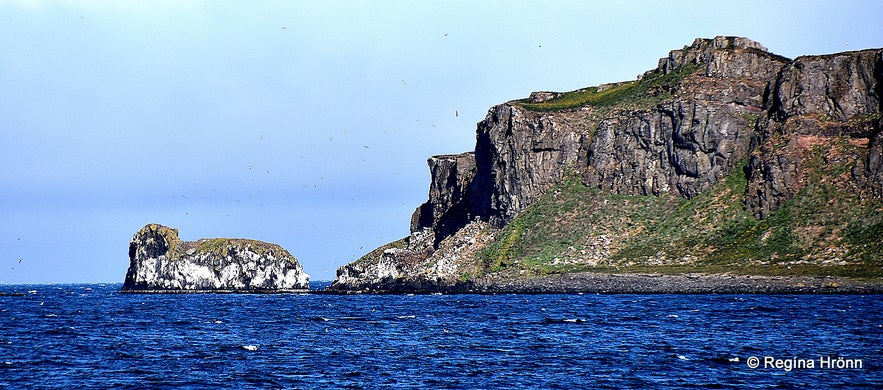
Uxinn - the Bull by Grímsey island in Steingrímsfjörður
I have heard an explanation about why the trolls wanted to keep the Westfjords Region to themselves and live there while the Vikings could keep the mainland.
Trolls are not Christian and hate the sound of church bells, so they most likely just wanted to stay in peace in the Westfjords Region and well away from the church bells in Iceland.
So this folklore dates back to after the year 1000, after the Christianisation of Iceland. You can find out more about the Christianisation of Iceland in my travel-blog about Goðafoss: The Historic Goðafoss Waterfall in Skjálfandafljót River in North Iceland.
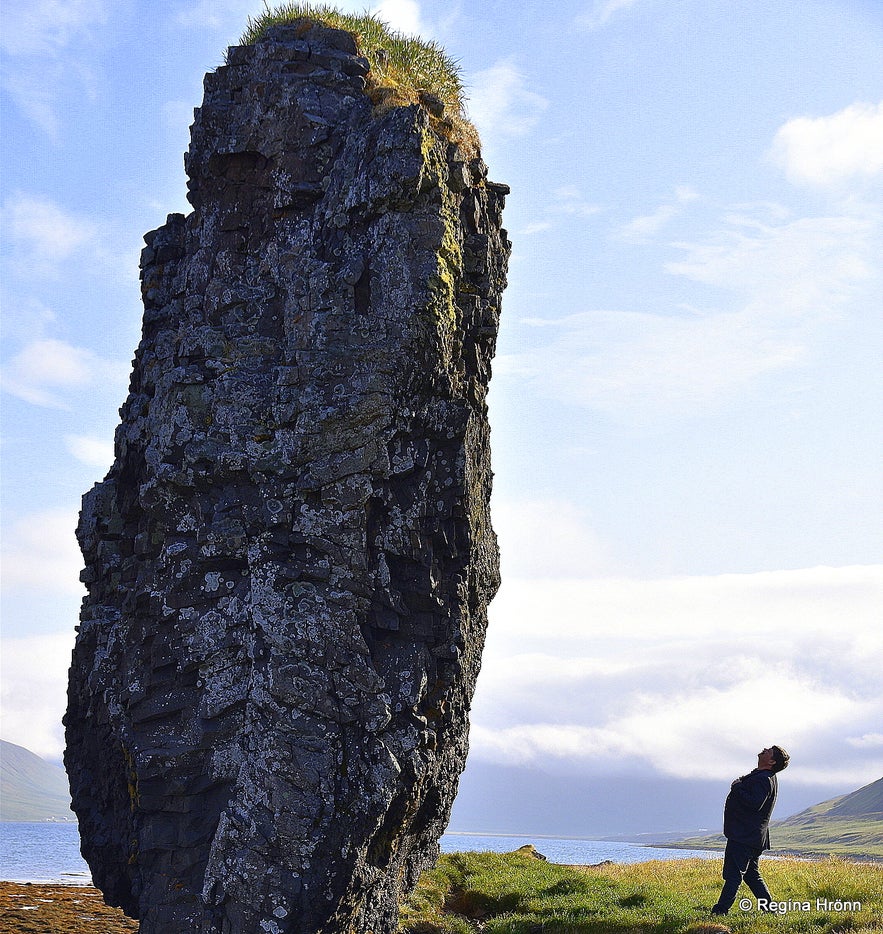
The troll in Kollafjörður is huge compared to my husband
You will see such pillars of rock in many places in Iceland and many of them have folklore connected to them. They are either called Kerling or Karl, depending on their sex and they usually come in pairs; Karl and Kerling.
Not the one in Drangsnes though as she stands alone and has no male troll, only the bull.
Drangsnes gets its name from this pillar of rock, but such a pillar of rock is called drangur in Icelandic. The pillars of rock in this travel-blog are typical dykes.
See also my travel-blog:
Kerlingarskarð Pass in Snæfellsnes in West-Iceland - the Folklore of the Giantess & her Fiancé
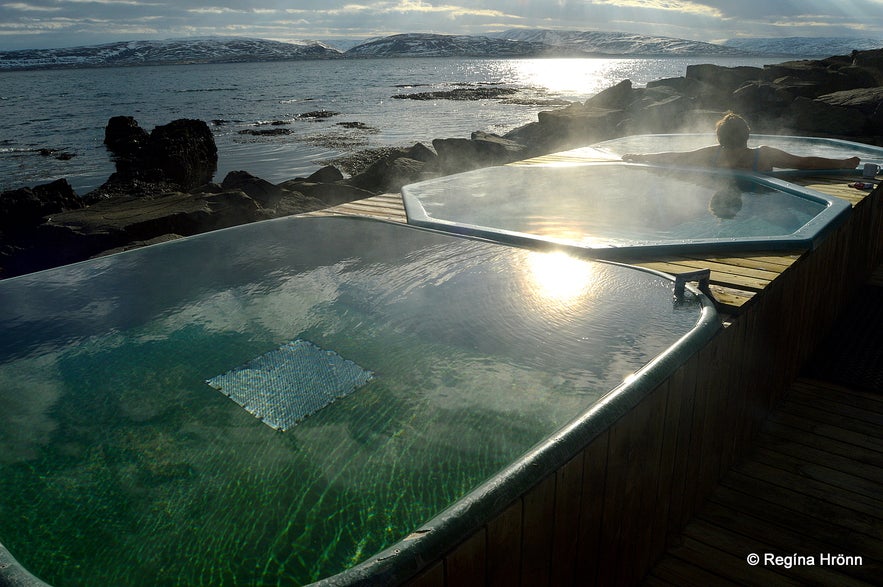
The hot tubs by the sea in Drangsnes at Strandir in the Westfjords Region, the Troll, and the Hot Tubs
I have written a long travel-blog about my trip to Strandir The remote Strandir in the Westfjords Region of Iceland - Stillness & Sorcery if you want to know what this sparsely populated area of the Westfjords has got to offer.
And if you want to see an elf-rock close to the Westfjord trolls, then I have included it in my previous travel-blog: 3 Wonderful Days at Kirkjuból and the Sheep Farming Museum at Strandir in the Westfjords Region.
Also check out the interesting villages close by:
Hólmavík in the Westfjords Region of Iceland - the Sorcery Town!
The Museum of Icelandic Witchcraft and Sorcery at Hólmavík in the Westfjords Region of Iceland
Have a lovely time at Strandir and I hope you get to greet the trolls :)
기타 흥미로운 블로그
요쿨살론부터 비크까지, 꽃보다 청춘 5화
드디어 하늘씨과 쓰리스톤즈가 합류했는데요! 설원을 달리는 모습에 저도 아이슬란드가 엄청 그리워졌답니다. 빙하와 빛나는 요쿨살론 첫번째로 향한 요쿨살론(Jokulsarlon)은 아이슬란드의 대표적인 명소 중 하나랍니다. 영어로 Glacier lagoon 이라고도 하는데요. 방송에 나온 것처럼 눈 앞에 보이는 빙하는 빙하수가 흘러서 녹았다 얼었다를더 보기스코가포스 폭포부터 오로라까지, 꽃보다청춘 4화를 따라서
여행 5일째, 포스톤즈가 처음으로 향한 곳은 아이슬란드 남부에 있는 스코가포스 폭포(skogasfoss)입니다. 아이슬란드 남부의 대표적인 폭포 중 하나에요. 방송에서는 들르지 않았지만 스코가포스 거의 바로 옆에 위치한 셀리야란드스포스(seljalandsfoss) 폭포와 함께 같이 들르곤 한답니다. 스코가포스 폭포는 폭포의 물줄기 끝까지 올라갈 수 있단더 보기꽃청춘을 따라서
요즘 인기리에 방영되고 있는 꽃보다 청춘 아이슬란드편! 저도 매주 빼놓지 않고 시청하고 있습니다. 많은 분들께서 포스톤즈의 발랄한 매력과 아이슬란드의 놀라운 경치에 빠져드셨을 것 같습니다! 이번에는 꽃보다 청춘을 따라서 아이슬란드를 한번 가보도록 해요! 사실 아이슬란드가 한국에서 그렇게 가기 쉬운 나라는 아닙니다. 거리도 멀고 항공권도 비싸고! 우더 보기

아이슬란드 최대의 여행 마켓플레이스를 전화에 다운로드하여 전체 여행을 한 곳에서 관리하세요
전화 카메라로 이 QR 코드를 스캔하고 표시되는 링크를 누르면 아이슬란드 최대의 여행 마켓플레이스를 주머니에 넣을 수 있답니다. 다운로드 링크가 포함된 SMS 또는 이메일을 받으려면 전화번호 또는 이메일 주소를 추가하세요.

